Rozafa Castle
Rozafa Castle (Albanian: Kalaja e Rozafës) is a castle near the city of Shkodër, in northwestern Albania. It rises imposingly on a rocky hill, 130 metres (430 ft) above sea level, surrounded by the Buna and Drin rivers. Shkodër is the seat of Shkodër County, and is one of Albania's oldest and most historic towns, as well as an important cultural and economic centre.
| Rozafa Castle | |
|---|---|
| Shkodër, in northwestern Albania | |
Fatih Sultan Mehmet Mosque within Rozafa castle | |
| Coordinates | 42.0465°N 19.4935°E |
| Site information | |
| Owner | |
| Controlled by | Illyrian tribes (Labeates, Ardiaei) Duklja Serbian Grand Principality Great Powers |
| Open to the public | Yes |
| Site history | |
| Materials | Limestone, brick |
History
Antiquity
Due to its strategic location, the hill has been settled since antiquity. It was an Illyrian stronghold during the rule of the Labeates and Ardiaei, whose capital was Scodra.[1]
During the Third Illyrian War the Illyrian king Gentius concentrated his forces in Scodra. When he was attacked by the Roman army lead by L. Anicius Gallus, Gentius fled into the city and was trapped there hoping that his brother Caravantius would come at any moment with a large relieving army, but it didn't happen. After his defeat, Gentius sent two prominent tribal leaders, Teuticus and Bellus, as envoys to negotiate with the Roman commander.[2] On the third day of the truce, Gentius surrendered to the Romans, was placed in custody and sent to Rome. The Roman army marched north of Scutari Lake where, at Meteon, they captured Gentius' wife queen Etuta, his brother Caravantius, his sons Scerdilaidas and Pleuratus along with leading Illyrians.[3]
The fall of the Ardiaean Kingdom in 168 BC[4] is transmitted by Livy in a ceremonial manner of the triumph of Anicius in Rome:
In a few days, both on land and sea did he defeat the brave Illyrian tribe, who had relied on their knowledge of their own territory and fortifications.
Medieval and Ottoman period
The 19th-century German author and explorer Johann Georg von Hahn suggested that the ancient and medieval city of Shkodër was located immediately south of the Rozafa hill, between the hill and the confluence of Buna and Drin. The fortifications, as they have been preserved to date, are mostly of Venetian origin.[5]
Within the Castle there are the ruins of a 13th-century Venetian Catholic church, considered by scholars as the St. Steven's Cathedral, which after the siege of Shkodër in the 15th century, when the Ottoman Empire captured the city, was transformed into the Fatih Sultan Mehmet Mosque.[6]
The castle has been the site of several famous sieges, including the siege of Shkodër of 1478-79 and the siege of Shkodër of 1912-13. The castle and its surroundings form an Archaeological Park of Albania.
Legend
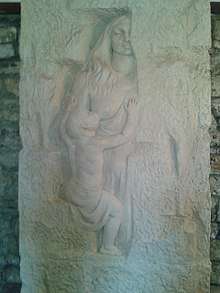
There is a famous legend among Albanians associated with the construction of the Rozafa Castle, which has been transmitted orally from ancient times, with immurement and human sacrifice as main themes.[7][8]
The story tells about the initiative of three brothers who set down to build a castle. They worked all day, but the foundation walls fell down at night. They met a wise old man who seems to know the solution of the problem asking them if they were married. When the three brothers responded positively, the old man said:[7]
If you really want to finish the castle, you must swear never to tell your wives what I am going to tell you now. The wife who brings you your food tomorrow you must bury alive in the wall of the castle. Only then will the foundations stay put and last forever.
The three brothers swore on besa to not speak with their wives of that happened. However the two eldest brothers broke their promise and quietly told their wives everything, while the honest youngest brother kept his besa and said nothing. The mother of the three brothers knew nothing of their agreement, and while the next afternoon at lunch time, she asked her daughters-in-law to bring lunch to the workers, two of them refused with an excuse. The brothers waited anxiously to see which wife was carrying the basket of food. It was Rozafa, the wife of the youngest brother, who left her younger son at home. Embittered, the youngest brother explained to her what the deal was, that she was to be sacrificed and buried in the wall of the castle so that they could finish building it, and she didn't protest but, worried about her infant son, she accepted being immured and made a request:[7]
I have but one request to make. When you wall me in, leave a hole for my right eye, for my right hand, for my right foot and for my right breast. I have a small son. When he starts to cry, I will cheer him up with my right eye, I will comfort him with my right hand, I will put him to sleep with my right foot and wean him with my right breast. Let my breast turn to stone and the castle flourish. May my son become a great hero, ruler of the world.
Gallery
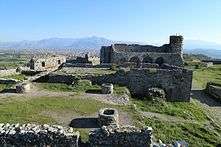
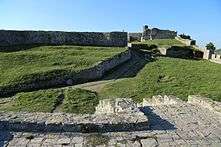
 Minaret of the Fatih Sultan Mehmet Mosque
Minaret of the Fatih Sultan Mehmet Mosque
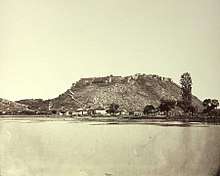 Rozafa castle in 1863
Rozafa castle in 1863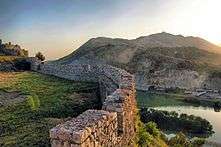 Church of the Holy Mother of God
Church of the Holy Mother of God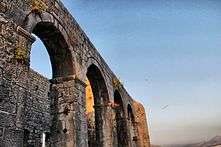 Ruins of the castle
Ruins of the castle
See also
| Wikimedia Commons has media related to Rozafa. |
- Albanian mythology
- Constantin and Doruntine
- Tourism in Albania
References
- Evans 2006, p. 83.
- Berranger 2007.
- Wilkes 1995, p. 174.
- Wilkes 1995, p. 72.
- Von Hahn 1854, pp. 94-96.
- Kiel 1990, p. 230.
- Elsie 1994, p. 32.
- Fischer 2002, p. 6.
- "DRKK Shkodër". www.facebook.com. Retrieved 2018-06-12.
Sources
- Fischer, Bernd j. (2002). Albanian identities: myth and history. Indiana University Press. ISBN 978-0-253-34189-1. Retrieved 23 September 2010.CS1 maint: ref=harv (link)
- Wilkes, J. J. (1995). The Illyrians. Oxford, United Kingdom: Blackwell Publishing. ISBN 0-631-19807-5.CS1 maint: ref=harv (link)
- Von Hahn, J.G. (1854). Albanesische Studien. Jena: Verlag von Friedrich Mauke.CS1 maint: ref=harv (link)
- Kiel, Machiel (1990). Research Centre for Islamic History, Art and Culture (ed.). Ottoman architecture in Albania (1385-1912). Islamic art series (in German). Band 5. Istanbul. ISBN 92-9063-330-1.CS1 maint: ref=harv (link)
- Berranger, Danièle (2007). Épire, Illyrie, Macédoine: mélanges offerts au professeur Pierre Cabanes. Presses Univ Blaise Pascal. ISBN 2845163517.CS1 maint: ref=harv (link)
- Evans, Arthur; et al. (J. J. Wilkes) (2006). Ancient Illyria: An Archaeological Exploration. I.B.Tauris. ISBN 1845111672.CS1 maint: ref=harv (link)
- Elsie, Robert (1994). Albanian Folktales and Legends (pdf). Naim Frashëri Publishing Company.CS1 maint: ref=harv (link).
